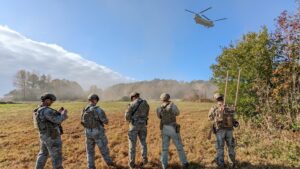A Navy program office this week announced the Joint Counter Radio-Controlled Improvised Explosive Device (RCIED) Electronic Warfare (JCREW) program reached full operational capability (FOC) ahead of schedule.
The July 25 announcement by the Program Executive Office for Unmanned and Small Combatants (PEO USC) specifies this is the Increment One Block One (I1B1) version of the JCREW that reaches FOC.
JCREW is a jammer that aims to defend against radio-controlled IEDs.

The JCREW I1B1 system achieving FOC means the Navy has met its inventory requirements for the systems, with operators trained to use and maintain the system while a supply support infrastructure is also in place. This includes a government-owned and operated depot for repair of the JCREW.
The I1B1 family of systems specifically shares common hardware and software while seeking to protect against the RCIEDs. The systems are divided into mounted, dismounted and fixed site capabilities.
Mounted systems are geared at protecting mobile ground units from RCIEDs; dismounted or “manpack” systems are carried by individual warfighters; while fixed site systems cover temporary, semi-permanent and permanent facilities and infrastructure like airfields, buildings, guard posts and compounds.
According to the Navy, the JCREW I1B1 program includes a full government-owned technical data package (TDP), open architecture hardware, upgradable software and firmware and an integrated test mechanism “that verifies readiness to operate without the need for external test equipment.”
A TDP generally allows the government to share all the elements needed to build and maintain a system with multiple suppliers or builders, allowing multiple or different producers of the same system.
“The I1B1 program achieving full operational capability shows our commitment to the warfighter, who can now fully employ this technology in multiple domains to counter threats from RCIEDs,” Capt. Jon Haase, Expeditionary Missions program manager, said in a statement.
The JCREW I1B1 is currently used by the U.S. Navy and Air Force as well as the Australia and New Zealand militaries.